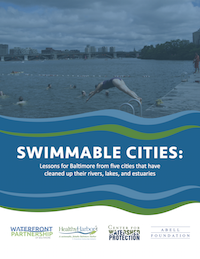Five Cities That Show Baltimore’s Harbor Can Be Swimmable
 A new report offers hope that Baltimore will eventually make its Harbor fishable and swimmable, along with some lessons that will make it easier to achieve that goal.
A new report offers hope that Baltimore will eventually make its Harbor fishable and swimmable, along with some lessons that will make it easier to achieve that goal.
Swimmable Cities: Lessons for Baltimore from Five Cities that Have Cleaned Up Their Rivers, Lakes and Estuaries was produced by the Center for Watershed Protection and released by the Waterfront Partnership of Baltimore, with funding by the Abell Foundation.
The report examines five American cities that have achieved significant reduction in sewage pollution and have witnessed their waterways again become a major recreational and economic engine.
- The City of Atlanta reduced their untreated sewage flows to the Chattahoochee by 99% from the 1990s to 2014.
- In July 2013, recreational swimming for the general public was permitted in Boston’s Charles River for the first time in over 50 years.
- Los Angeles has reduced 83% of their sanitary sewer overflows since 2000.
- Lake Pontchartrain was removed from the Louisiana Department of Environmental Quality impaired waters list for primary contact recreation as of 2006.
- In 2014, the Virginia Department of Environmental Quality issued a draft report that the Lafayette River meets water quality standards for recreational contact.
Through the water quality data and pollution reporting work that Blue Water Baltimore’s Baltimore Harbor Waterkeeper has been doing, we know that the challenges facing the Baltimore Harbor are not entirely different from those that these five waterways initially faced.
Yet the case study cities have been more resourceful, more dynamic, and more comprehensive in their approach to solving their sewage problems.
The report demonstrates that the process of cleaning up Baltimore’s waterways will work best when local and state agencies along with the Environmental Protection Agency are active in their roles as both funders and enforcers of laws. Cities that saw success also benefited from organizations like Blue Water Baltimore holding these agencies accountable using both dialogue and collaboration along with enforcement actions when necessary.
Six key elements of the cleanup efforts in the case studies that have been missing in Baltimore:
- Addressing both wet and dry weather sewage flows
- Measuring effectiveness using water quality endpoints
- Providing multiple lines of enforcement
- Garnering support from state and federal partners
- Fostering strong local partnerships
- Incorporating technological innovations
These case studies show that comparable cities across the country have been successful at eliminating sewage flowing into their rivers and harbors. Baltimore’s sewage problems, remedial actions, and financial resources dedicated to the cleanup are in line with that of other cities, but Baltimore has yet to see significant water quality improvements.

